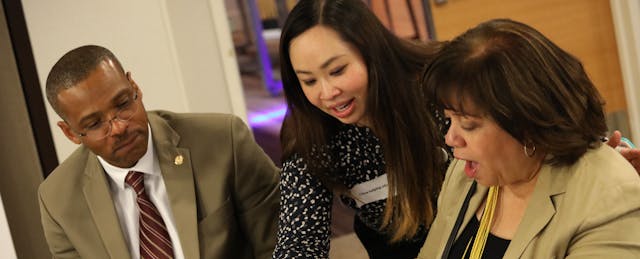How can historically black colleges and universities provide meaningful employment to struggling students and alumni? Leaders of 24 institutions serving them are answering this question in Atlanta this week as part of a conference hosted by United Negro College Fund’s (UNCF) Career Pathways Initiative (CPI).
The program seeks to close the ever widening chasm between the professional outcomes and economic mobility of black and white college students. Jim Shelton, former Deputy Secretary of Education in the Obama administration and president of Education at the Chan Zuckerberg Initiative who kicked off the event, said the pace of change is critical. “The ability to learn at the pace of the fastest learner is the key to success,” he said. The 54,000 students served by these institutions are some of our country’s most vulnerable.
Improving African American’s economic mobility through education and professional development represents one of today’s most urgent social justice challenges. “A lot of these students come from low-income backgrounds,” explains Michael Lomax, UNCF president and chief executive officer. “They attend college to change their economic status and that of their families. It’s a perverse outcome when they borrow significantly, go to school, work hard, and then can’t get good jobs after they graduate.” Lomax believes that by “moving the goalpost from graduation to employment” and designing for “practical and pragmatic outcomes” the organization can lead in industry traditionally resistant to change.
Two years ago, the Lilly Endowment announced its $50 million dollar grant to UNCF, the second largest gift in the organization’s history and named by Forbes as one of the biggest bets in philanthropy.

The data paint a complex picture of HBCUs. According to the Center for Economic Policy Research, the unemployment rate for African American graduates, ages 22 to 27, was 12.4 percent in 2013, more than twice the rate of their white counterparts. In 2016, the Bureau of Labor Statistics reported the overall unemployment rate for African Americans is 8.4 percent, almost double than their white counterparts at 4.3 percent. Research also shows black students borrowing more, and carrying a higher debt load.
Yet despite facing higher underemployment and debt, HBCU graduates also report feeling greater satisfaction with their experience than their peers at predominantly white institutions. A recent Gallup-Purdue poll reports 55 percent of black HBCU graduates agreed their college experiences prepared them well for outside of college, compared to less than 30 percent of their non-HBCU black counterparts.
Ask any of the 180 attendees who convened at Atlanta’s downtown Marriott and they will agree. “It’s [a] lot of money,” says Oakwood University President Leslie N. Pollard, Ph.D. Oakwood, founded by the Seven Day Adventist Church in Huntsville, Ala., received over $2.75 million from the Lilly Endowment to redesign their career offerings. These grants are significant gifts for these institutions. Pollard and his HBCU president peers face a challenging mandate: to create efficient, scalable, innovative programs that are sustainable after the five-year grant term ends. “It’s a burst of creative resources that jumpstarts our work for greater purposes.”
| Institution | Implementation Award |
| Benedict College | $1,500,000 |
| Claflin University | $3,300,000 |
| Clark Atlanta University | $1,500,000 |
| Dillard University | $1,000,000 |
| Fayetteville State University | $1,500,000 |
| Fisk University | $1,000,000 |
| Florida Memorial University | $1,250,000 |
| Huston-Tillotson University | $1,000,000 |
| Jarvis Christian College | $1,000,000 |
| LeMoyne-Owen College | $1,000,000 |
| Morehouse College | $1,250,000 |
| Morgan State University | $2,000,000 |
| Norfolk State University | $2,000,000 |
| Oakwood University | $2,750,000 |
| Rust College | $1,000,000 |
| Spelman College | $1,250,000 |
| Talladega College | $1,250,000 |
| Tennessee State University | $2,000,000 |
| Tougaloo College | $2,000,000 |
| University of West Alabama | $1,250,000 |
| Voorhees College | $1,200,000 |
| Wilberforce University | $1,000,000 |
| Wiley College | $1,000,000 |
| Xavier University of Louisiana | $1,250,000 |
To ensure these funds are put to the best use, UNCF hosts a gathering of grant recipients every year to design their programs, share best practices, and work collaboratively. This is the second annual conference. For three days, attendees have been heads down in an capacity building design sprint led by Education Design Lab.
In the ballroom, groups huddled around oversized sheets of paper and sticky notes, creating student journey maps, identifying patterns and themes, and scrutinizing the plans they’ve proposed: is the process integrated into the curriculum? Is it measurable and data-driven? Does it respond to the needs of all students? Does it deliver a network of social and cultural capital that’s necessary to be successful in the world of, “It’s who you know, not what you know”?
The ideas they generate could be industry-changing. Here’s why: The CPI grantees are being forced to take risks, experiment, iterate, put student success first, and design agile services for a 21st century economy. This group of innovators is being forced to “disrupt themselves” and adopt new strategies to replace traditional, legacy practices like career fairs, administrative and departmental siloes, and an emphasis on one-on-one student and career counselor advising.

Here are the five major themes that have emerged from UNCF’s Career Pathways Initiative with the potential to be broadly applied across the higher-ed industry.
1. Collaboration is key
Silos are the great killer of progress in higher education. But with this group, almost no silo is sacred. Florida Memorial University is completely rethinking its approach. A graduate’s average starting salary is just under $27,000. “Professional success should be everyone’s job,” said Dr. Tamar Riley, Director of Graduate Programs and Associate Professor of Exceptional Student Education. Faculty are leading the way by integrating practical skill-building into the student coursework; participating in professional development trainings; and receiving financial bonuses for reaching performance goals. “Faculty are at the front lines. If you don’t have their buy-in you can’t move the needle,” Riley stated.
2. Software is not a silver bullet
During his presentation, Dr. Michael Baston, incoming president at Rockland Community College, gestured to the exhibitors’ booths and noted the rise of edtech products that overpromise, underdeliver, and mask over necessary change at a human level. “Some of the institutions just buy stuff thinking that stuff is going to solve the problems. It doesn’t matter how many tools that you buy….[we] cannot use technology to replace our common sense and thinking,” he cautioned. He likened the fast, and sometimes uneducated adoption of useless tools to cable TV subscriptions. “I bet some of you...have a hundred, thousand channels and you only watch three.”
3. Grassroots, not top down
Oakwood’s President Pollard sees a major shift in the way career services programs are being designed. Presidents no longer dictate mandate from on high. Instead, their role is to facilitate collaborations with all campus stakeholders that are “flexible, porous, and nimble.” The conference intentionally involves younger leaders and new voices who are closer to the problems they’re trying to solve.
4. A curriculum that leads to a career
One of the most significant undertakings is reexamining the curriculum and asking how each credit hour can be put to better use. At Oakwood, the school is redesigning the course load and granting skills certification after every year so no student walks away empty handed. After many decades of considering a more efficient redistribution of credit hours, Clark Atlanta University now offers students the opportunity to pursue a major, minor, and certificate. Tiara Hector, Director of Career and Professional Development , said this is what employers are telling her they want. “No one just wants a business major anymore. They are looking for business and a minor in Spanish with a certificate in computer science. Redesigning the credentials students walk away with makes them three times more marketable. This is what we need to stay competitive.”
5. Changing campus culture
A “one-size-fits-all” approach is no longer sustainable.The college experience—at HBCUs and elsewhere—demands a completely new approach to meet students’ needs. Women’s campuses must now consider admitting students that identify as transgender. International students are anxious about deportation in an uncertain political climate. First-generation students lacking the social and professional networks of their peers must connect with employers in new ways, while part-time students with children juggle childcare and work. With only 17 percent of students reporting that their campus career offices were helpful, CPI schools have identified an opportunity to meet students where they are.
“There has been too much conversation about whether students are ‘college ready’,” said Dr. Baston. “The conversation in this generation has to be: is the college student-ready? Has the college created the structures, the systems, the platforms, the practices that make it a place where those students are nurtured, cared for, loved, attended to?” For HBCUs and higher education alike that time, urged Dr. Baston, is now.


